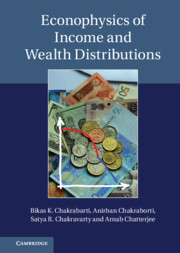Book contents
- Frontmatter
- Contents
- Preface
- 1 Introduction
- 2 Income and wealth distribution data for different countries
- 3 Major socioeconomic modelling
- 4 Market exchanges and scattering process
- 5 Analytic structure of the kinetic exchange market models
- 6 Microeconomic foundation of the kinetic exchange models
- 7 Dynamics: generation of income, inequality and development
- 8 Outlook
- References
- Index
3 - Major socioeconomic modelling
Published online by Cambridge University Press: 05 May 2013
- Frontmatter
- Contents
- Preface
- 1 Introduction
- 2 Income and wealth distribution data for different countries
- 3 Major socioeconomic modelling
- 4 Market exchanges and scattering process
- 5 Analytic structure of the kinetic exchange market models
- 6 Microeconomic foundation of the kinetic exchange models
- 7 Dynamics: generation of income, inequality and development
- 8 Outlook
- References
- Index
Summary
In this chapter, we discuss the background and motivation for various modelling efforts carried out over the years. While some models take into account the various details as in real economic transactions, trying to fit the detailed characteristics of empirical data, others reproduce the empirical features qualitatively using very simple ideas of physical origin.
Models of income distribution
Pareto's extensive studies in Europe showed that the tail of the wealth distribution for the richer sections of society follows a power law (Pareto 1897), now known as the Pareto law. Gibrat (1931) separately worked on the same problem and proposed a law of proportionate development. Much later, Champernowne also considered this problem systematically and proposed a probabilistic theory to justify Pareto's claim (Champernowne 1953; Champernowne and Cowell 1998).
Gibrat (1931) observed that the power law distribution did not fit all the income data and hence proposed a law of proportionate effect, which states that a small change in a quantity is independent of the quantity itself. Thus the distribution of a quantity dz = dx/x should be Gaussian, and hence x is log-normal. The asymptotics of this can lead to the Pareto power law. Gibrat found that the small-and middle-income ranges appear to be well described by a log-normal distribution (see Eq. (2.3)). The details of Gibrat's law and its derivation will be presented in Chapter 7.
- Type
- Chapter
- Information
- Econophysics of Income and Wealth Distributions , pp. 35 - 54Publisher: Cambridge University PressPrint publication year: 2013



